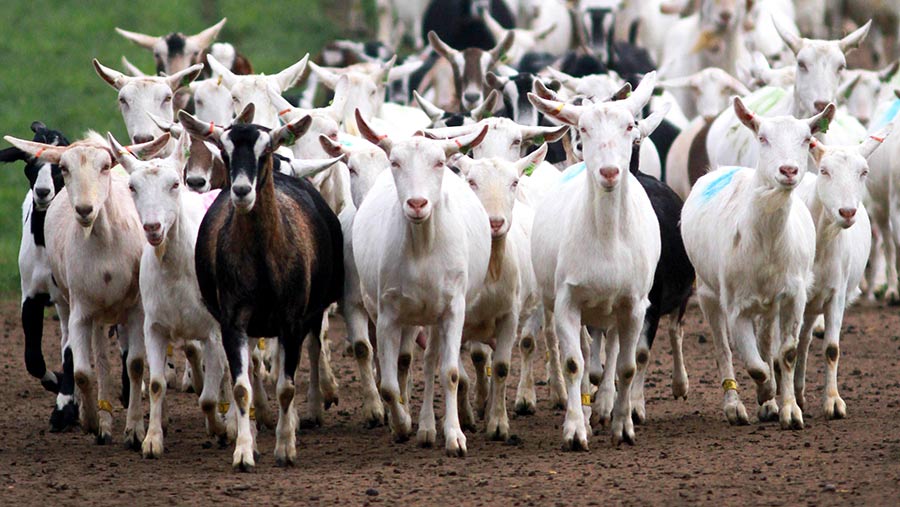Advice for maintaining goat herd health
 © AlamyStock/Joanne Roberts
© AlamyStock/Joanne Roberts Commercial dairy goat farming is growing rapidly in the UK, but keeping herds healthy is a challenge when an animal with a naturally low immunity to disease is farmed in a housed system.
Mortality and culling rates can be higher than in other livestock sectors – some producers cull up to 30% of their herds annually – so farmers are working with their vets to prevent disease and reduce risk factors.
At Glandwr Farm, near Llandovery, Meirion and Sharon Evans, and their sons, Meredydd and Morgan, have a comprehensive health plan in place to protect their 800 Saanen milkers.
See also: 6 top tips for getting into milking goats
The Evans family established their dairy goat herd three years ago and were aware that the greatest risk factor to goat health was their flock of 600 ewes – because sheep and goats share many of the same diseases.
“We do everything we can to prevent cross-contamination between the goats and sheep,’’ Mr Evans explains.
“The goats will pick up any sheep scab, foot rot, lice, ticks and clostridia infections, so we have very strict biosecurity procedures and everyone who works on the farm is aware of those.’’
Goats and sheep have their own yards and housing and there are separate quad bikes and trailers for moving goats and kids and sheep and lambs.
Everyone on the farm has separate protective clothing and footwear when handling the different species. “We take this very seriously, even down to having two shepherd’s crooks,” says Mr Evans.
Establishing the herd and kidding
The introduction of new animals poses the single greatest risk to biosecurity, so when the Evans family established the business the goats were sourced from a closed herd. Diseases in goats are not always apparent in the early stages, so the animals were regularly monitored for signs of illness.
Point of kidding is the highest-risk period because goats mostly have multiple births and require intervention around kidding.
Mr Evans says hygiene levels are especially high at this time to prevent infection that can rapidly result in toxaemia and metritis. Goats kid from January to April, with kids fed colostrum for three days.
Nutrition
Goats are susceptible to twin kid disease, especially nannies that are over-conditioned, so nutrition is important.
At Glandwr Farm, the diet consists of straw and cake instead of the more usual TMR. Average annual yield is 1,000 litres with milk sold to Abergavenny Fine Foods.
Matthew Pugh, of Belmont Farm and Equine Vets, Hereford, recommends splitting goats according to predicted kidding dates.
“Blanket feeding should be avoided,’’ he says. “As with dairy cows, management in the dry period is important. Goat farmers should be thinking about the next lactation as soon as pregnancy is confirmed. If goats get fat in late lactation, they will be prone to fatty liver.’’
Condition scores?
Attention to detail is central to neonatal kid care at Glandwr Farm. Kids are born in a clean and dry environment and their navels dipped. A comprehensive vaccination programme for both kids and adult goats is a cornerstone of the health plan.
At three weeks, seven weeks and six months, kids are vaccinated against pasteurellosis. At four and eight weeks, they are vaccinated with Lambivac and at 10 weeks a vaccination is given to protect against Johne’s. There are further vaccinations at five months, for enzootic abortion and toxoplasmosis. Adult goats get a Lambivac booster in January and July.
Mr Pugh says levels of stockmanship need to be high on goat farms to control all diseases, from Johne’s to infectious scour in kids.
He recommends the removal of kids from the kidding area as soon as possible after birth. “Ensure all kids receive adequate colostrum in the first four hours after birth. The recommended level is 250ml within those four hours.’’
Matthew Pugh’s top tips for high health status in dairy goat herds
- Establish an active health plan in conjunction with your vet.
- Make everyone aware of protocols, including interventions around kidding, such as ensuring kids receive adequate colostrum and that any animals with assisted kiddings are treated quickly and effectively.
- Ensure everyone is suitably trained and skilled. “No one should be afraid to ask questions. Consider having a small training event in conjunction with your vet.’’
- Everyone involved in the farm, including nutritionists, vets and consultants, should work as a team.
- Adopt a zero-tolerance approach to the control of infectious diseases such as foot rot and infectious abortions.
- To allow for informed decisions when buying goats, ensure your vet speaks to the vendor’s vet to establish the health status of the flock.
